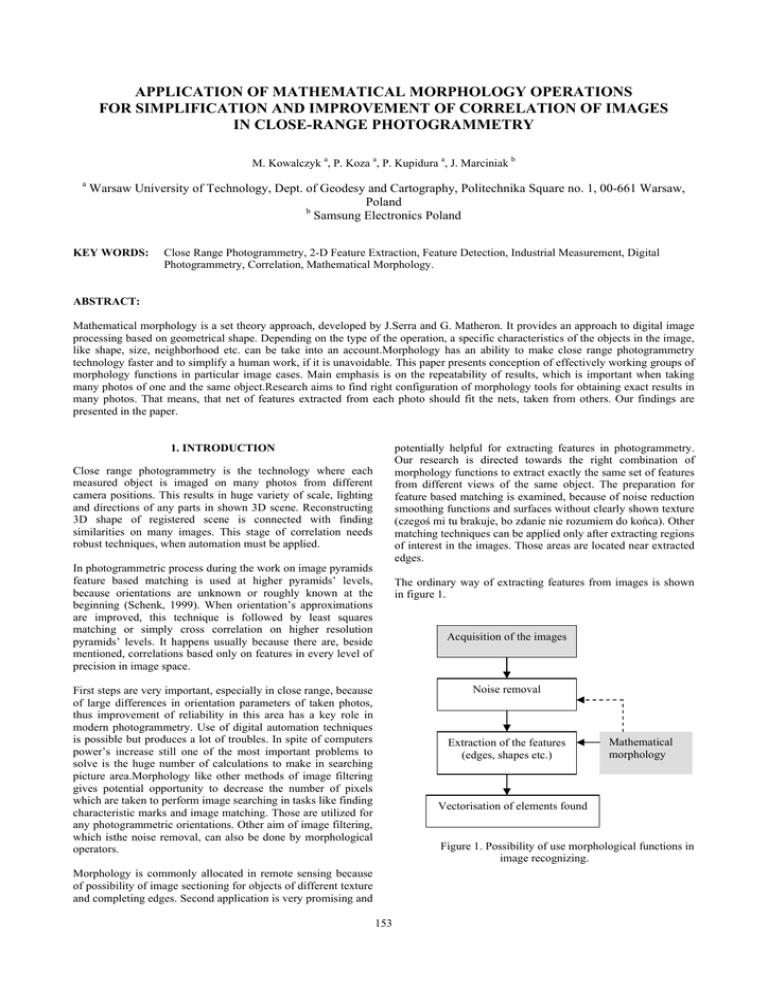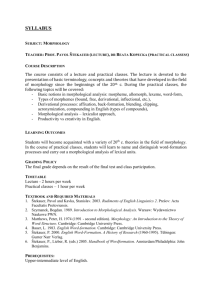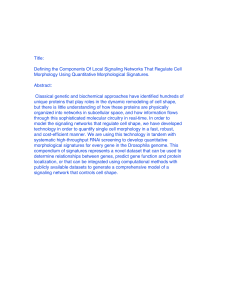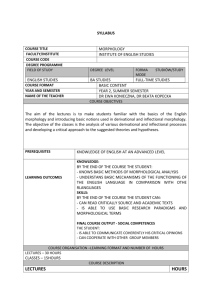APPLICATION OF MATHEMATICAL MORPHOLOGY OPERATIONS
advertisement

APPLICATION OF MATHEMATICAL MORPHOLOGY OPERATIONS FOR SIMPLIFICATION AND IMPROVEMENT OF CORRELATION OF IMAGES IN CLOSE-RANGE PHOTOGRAMMETRY M. Kowalczyk a, P. Koza a, P. Kupidura a, J. Marciniak b a Warsaw University of Technology, Dept. of Geodesy and Cartography, Politechnika Square no. 1, 00-661 Warsaw, Poland b Samsung Electronics Poland KEY WORDS: Close Range Photogrammetry, 2-D Feature Extraction, Feature Detection, Industrial Measurement, Digital Photogrammetry, Correlation, Mathematical Morphology. ABSTRACT: Mathematical morphology is a set theory approach, developed by J.Serra and G. Matheron. It provides an approach to digital image processing based on geometrical shape. Depending on the type of the operation, a specific characteristics of the objects in the image, like shape, size, neighborhood etc. can be take into an account.Morphology has an ability to make close range photogrammetry technology faster and to simplify a human work, if it is unavoidable. This paper presents conception of effectively working groups of morphology functions in particular image cases. Main emphasis is on the repeatability of results, which is important when taking many photos of one and the same object.Research aims to find right configuration of morphology tools for obtaining exact results in many photos. That means, that net of features extracted from each photo should fit the nets, taken from others. Our findings are presented in the paper. potentially helpful for extracting features in photogrammetry. Our research is directed towards the right combination of morphology functions to extract exactly the same set of features from different views of the same object. The preparation for feature based matching is examined, because of noise reduction smoothing functions and surfaces without clearly shown texture (czegoś mi tu brakuje, bo zdanie nie rozumiem do końca). Other matching techniques can be applied only after extracting regions of interest in the images. Those areas are located near extracted edges. 1. INTRODUCTION Close range photogrammetry is the technology where each measured object is imaged on many photos from different camera positions. This results in huge variety of scale, lighting and directions of any parts in shown 3D scene. Reconstructing 3D shape of registered scene is connected with finding similarities on many images. This stage of correlation needs robust techniques, when automation must be applied. In photogrammetric process during the work on image pyramids feature based matching is used at higher pyramids’ levels, because orientations are unknown or roughly known at the beginning (Schenk, 1999). When orientation’s approximations are improved, this technique is followed by least squares matching or simply cross correlation on higher resolution pyramids’ levels. It happens usually because there are, beside mentioned, correlations based only on features in every level of precision in image space. The ordinary way of extracting features from images is shown in figure 1. Acquisition of the images Noise removal First steps are very important, especially in close range, because of large differences in orientation parameters of taken photos, thus improvement of reliability in this area has a key role in modern photogrammetry. Use of digital automation techniques is possible but produces a lot of troubles. In spite of computers power’s increase still one of the most important problems to solve is the huge number of calculations to make in searching picture area.Morphology like other methods of image filtering gives potential opportunity to decrease the number of pixels which are taken to perform image searching in tasks like finding characteristic marks and image matching. Those are utilized for any photogrammetric orientations. Other aim of image filtering, which isthe noise removal, can also be done by morphological operators. Extraction of the features (edges, shapes etc.) Mathematical morphology Vectorisation of elements found Figure 1. Possibility of use morphological functions in image recognizing. Morphology is commonly allocated in remote sensing because of possibility of image sectioning for objects of different texture and completing edges. Second application is very promising and 153 The International Archives of the Photogrammetry, Remote Sensing and Spatial Information Sciences. Vol. XXXVII. Part B5. Beijing 2008 which removes any features not similar to geometry of pipe cracks. In the end after crack enhancement the digital model of defects is produced. 2. LITERATURE REVIEW 2.1 Basics of Mathematical Morphology Mathematical morphology is a set theory approach, developed by J.Serra and G. Matheron. It provides an approach to processing of digital images that is based on geometrical shape. Two fundamental morphological operations – erosion and dilation are based on Minkowski operations. There are two different types of notations for these operations: Serra/Matheron notation and Haralick/Sternberg notation. In this paper Haralick/Sternberg notation, which is probably more often used in practical applications, is used. In this notation erosion is defined as follows (Eq. 1) (Serra, 1982): Architectural monuments as well as industrial objects have edges and parts which can be possibly detected by usage of mathematical morphology functions. The author of the paper (Rodehost, 1997) described dividing images into different parts where morphology takes role in preparation for final stage in proposed solution. Opening is taken for separation of stones in ancient wall.Edge detection and especially discontinuities of acquired surfaces is the main issue of the paper (Jiang, Bunke, 1999). Instead of photo images authors worked with range images produced by laser scanner in close range measuration tasks. Edges were created also by rapid changes of the normal to the reflected surfaces. (1) 3. EXPERIMENTS and dilation (Eq. 2) as: Research consisted of preparation, noise removal and edge detection, aimed standard processing of images taken by digital camera. As pointed at the beginning the main goal was connected with possibly effective edge extraction. (2) where: 3.1 Preparation In experiment there was implemented common digital camera Pentax Optio A10 which has got relatively small image analyzer 1/1.8 " (7.18 x 5.32 mm)], producing large amount of noise even in small iso values. As the industrial object there was chosen Stereocomparator from Photogrammetric laboratory at Warsaw University of Technology (Figure 2). Camera was set to maximum resolution. Unfortunately without possibility of recording in RAW image format, Jpeg with lowest compression ratio had to be useed – about 3 MB for 8 megapixel RGB image (about 8 times compressed). (3) B and B̂ are structuring elements and (4) Idea of the morphological gradient, operation presented in (Beucher, 1990), comes out from the mathematical analysis. It can be defined as following (Eq. 3) (Nieniewski, 1998): (5) For the discreet data, where the circle is replaced by the 3x3 pixels square, we can define it as the difference between dilation and erosion of the input image (Eq. 4) (Nieniewski, 1998): Figure 2. Digital camera and object utilized in the experiment (6) 2.2 Applications Morphology as a tool for images transformation works in close range photogrammetry for many years. It has been used for extracting edges and detecting characteristic objects in mobile photogrammetry systems to making maps from images taken from a car, called mobile mapping systems (Tao, 1998). The author points into robustness of results during achievement of specific information from series of images as a main goal for future researching task. Morphology is used mainly for decrease an area of interest and extracting specific objects like e.g. road signs. Functions of morphology are also used in detecting sewer pipes defects. This application demands preprocessing where authors (Iyer, Sinha, 2005) applied median filter for noise removal. After that there is developed combination of functions called linear closing by reconstruction, Figure 3. Camera stations placement, surrounding Stereocomparator Pictures taken with ISO 400 had size in pixels 3264 x 2448, time of exposition was approximately 1/13 s with aperture 2.80, not smudgy. There had been chosen 4 from 17 images taken 154 The International Archives of the Photogrammetry, Remote Sensing and Spatial Information Sciences. Vol. XXXVII. Part B5. Beijing 2008 from camera positions surrounding object with about 1 meter distance (Figure 3). Example of noisy picture parts is shown in figure 4. a.) b.) c.) d.) Figure 4. Random results of brightness registration in images First action performed in pictures there was reduction of pixel depth from RGB to gray scale for usage of morphology algorithms in application Morpho 1.5. 3.2 Noise removal Then the next step of mostly applied image processing technologies is noise removal. It can be made by many available low-pass filters usually working fast and accurately. In experiment most important parts of images should left unmoved, thus images had been treated by two basic morphology functions working oppositely – erosion and dilation or those composition – opening and closing. Each case needs proper structural element depending on size of grains in picture noise. Order of this two functions is important because of existence of thin dark or light lines in imaged scene. Industrial objects have usually dark lines which appear on the edge of joining parts of the device, thus in the beginning should be used erosion or opening in order to prevent those edges from disappearing.Morphological filters base on a simple idea of alternating two operations: opening and closing – removing, respectively, small high-valued and low-valued objects from the image. These filters, called generally alternate filters differ from each other in the type of opening and closing operations applied. One of the morphological filters seems to be very effective. It is called Alternate Filter with Multiple Structuring Function (Element) – the sequence of opening and closing operations with multiple structuring element. It removes the small objects from the image but preserves edges and linear objects, what is very important for the purpose of image filtering as the preprocessing for edge detection. Its effectiveness was proved for other types of the images (Kupidura, 2006), (Kupidura, Koza, 2008) and they can be used in close-range photogrammetry as well. The reader is referred to the books and articles of mathematical morphology for an extended background to morphological operators (especially (Serra, 1982), (Haralick et al., 1987), (Nieniewski, 1998) and (Kupidura, 2006)). In addition common filter like median were checked for comparison to morphological ones. Results of this research are presented in figure 5. Local noise level is represented by absolute difference between quantisation value of taken pixel and medium value from its surrounding. In graphs are presented number of pixels from each difference like values in histogram from image. Figure 5. Number of standing out pixels from surrounding neighborhood. X axis shows value of the difference, Y axis shows relative number of pixels from part of the image d=2.2 original image a.), d=1.6 median 3x3 b.), d=1.4 median 5x5 c.), d=1.4 opening and closing d.) As shown in figure 4 combination of morphology functions reduces noise more strongly then median filter at the same size of operational element, but there is a danger of removal of smaller details. That performed action costs much more image operations. Usually morphological operations eliminate noisy pixels during other tasks and it is usually a side effect. 3.3 Edge detection Detection of the edges is the next step leading to extraction of characteristic features. There are some popular filters which are usually used to achieve this target. There was taken Sobel and Previtt filter as the reference to comparison with morphological tools. As the most effective combination of morphology functions is taken the difference between two images after applied erosion and dilation separately. Results are presented in pictures with inverted brightness (Figure 6 b,c,d). a.) b.) c.) d.) Figure 6. Separated edges by filers: Sobel – b.), Prewitt – c.), morphological gradient – d.), original fragment of the image – a.) 155 The International Archives of the Photogrammetry, Remote Sensing and Spatial Information Sciences. Vol. XXXVII. Part B5. Beijing 2008 Median filter used before morphological gradient affected position of the edges, so instead of it should be used combination of opening and closing.As mentioned at the beginning the main aim is to find exactly the same set of features from each photo taken of this object. Therefore feature should be found ,that depends on the repetitiveness of gained features like characteristic lines, placed on edges. For better results should be used adaptive filters [B. Svensson et al., 2006], which works differently in different image area, and differently in each image. They cause a lot more calculations in image processing. Last part of the process, before acquiring vectors from image, is thinning of detected linear objects. Therefore the simple procedure was used , which grouped pixels having enough high value in line and they were replaced by one in the middle of each set. That was performed both in horizontal and vertical direction. This solution was applied after all performed actions in images, and shows differences connected with noise pixels and uncompleted lines of edges (Figure 7). Criteria for choosing right configuration of procedure for acquiring points from images should be found independent of illumination conditions as well as setting relevant or flexible threshold for extracting points.Detected points by opening and closing for noise removal and morphological gradient for drawing edges presents figure 9. There are displayed differences in detection of the same parts of the object. a.) b.) b.) d.) Figure 7. Thinned edges after filtering by: ordinary looking for gradient procedure, threshold=30 – a.), for others threshold=25: Sobel filter – b.), Prewitt filter – c.), morphological gradient – d.) Results suggest applied filters give weights to marked edges, being in proportion to local gradient, and extracting them by one threshold leads to noisy detected features near limits of registration. Figure 8 presents improvement of detection reliability after applied noise removal filters. Figure 9. Registration of the points in subsequent images. 4. CONCLUSIONS a.) The presented results show the potential of mathematical morphology in the processing of the close-range photogrammetry data. The application of the morphological gradient returns the results that are comparable to the results of other, widely-used operations, like Sobel and Prewitt operations. The only significant difference can be seen in the result of the detection of the edges of the small objects, especially of size of the noise. b.) The noise suppression is the next topic in the preprocessing for the automatic corellation. The very important issue of filtering is to preserve the edges of the objects. The morphological Filter with Multiple Structuring Function seems to be very effective for this issue. The effectiveness of morphological operations used for the preparing of the close-range images for automatic corellations, especially the effectiveness of the edge preserving of the different types of filtration and the efficency of the morphological gradient as the non-directional edge detector are the subjects of the further research of the authors, so more precise results of the comparison of morphological and nonmorphological operations will be known in the near future. c.) d.) Figure 8. Found pixels in morphological gradient after applied noise removal filters: without filtering – a.), median 3x3 – b.), median 5x5 – c.), opening and closing – d.) 156 The International Archives of the Photogrammetry, Remote Sensing and Spatial Information Sciences. Vol. XXXVII. Part B5. Beijing 2008 Kupidura, P., Koza P., 2008. Radar imagery filtering with use of the mathematical morphology operations, submitted to print in Polish Journal of Environmental Science. ACKNOWLEDGEMENT Scientific work financed from the science funds for the year 2007-2008 as a research project. Nieniewski, M., 1998. Morfologia matematyczna w przetwarzaniu obrazów, Akademicka Oficyna Wydawnicza PLJ. Rodehorst, V., 1997. Architectural Image Segmentation REFERENCES Using Digital Watersheds. 7th Int. Conf. on Computer Analysis of Images and Patterns CAIP'97, Kiel, Germany, Sep. 10-12. Beucher, S., 1990. Segmentation d’Images et Morphologie Mathématique, PhD thesis, Ecole Nationale Supérieure des Mines de Paris. Schenk, T., 1999. Digital Photogrammetry. TerraScience. Haralick, R. M., Sternberg, S. R. Zhuang, X, 1987. Image Analysis using Mathematical Morphology, IEEE Transactions on Pattern Analysis and Machine Intelligence, Ju., 9(4), str. 532-550 Serra, J., 1982. Image Analysis and Mathematical Morphology, vol.1, Academic Press, London. Svensson, B., Andersson, M., Smedby, Ö., Knutsson, H., 2006. Shivprakash Iyer, Sunil K. Sinha J., 2005. Automated condition assessment of buried sewer pipes based on digital imaging techniques. Indian Institute of Science, Sep.–Oct., 85, 235–252 Efficient 3-D Adaptive Filtering for Medical Image Enhancement. Proceedings of the IEEE International Symposium on Biomedical Imaging. April. Jiang, X., Bunke, H., 1999. Edge Detection in Range Images Based on Scan Line Approximation. Computer Vision and Image Understanding, Vol. 73, No. 2, February, pp. 183–199. Tao, C.V., 1998. Mobile Mapping Technology for Road Network Data Acquisition 1. Journal of Geospatial Engineering, Vol. 2, No.2, pp. 1-13. Tokyo, Japan. Kupidura, P., 2006. Zastosowanie wybranych operacji morfologii matematycznej do wydzielania klas pokrycia terenu na zdjęciach satelitarnych, Phd thesis, Warsaw. 157 The International Archives of the Photogrammetry, Remote Sensing and Spatial Information Sciences. Vol. XXXVII. Part B5. Beijing 2008 158






